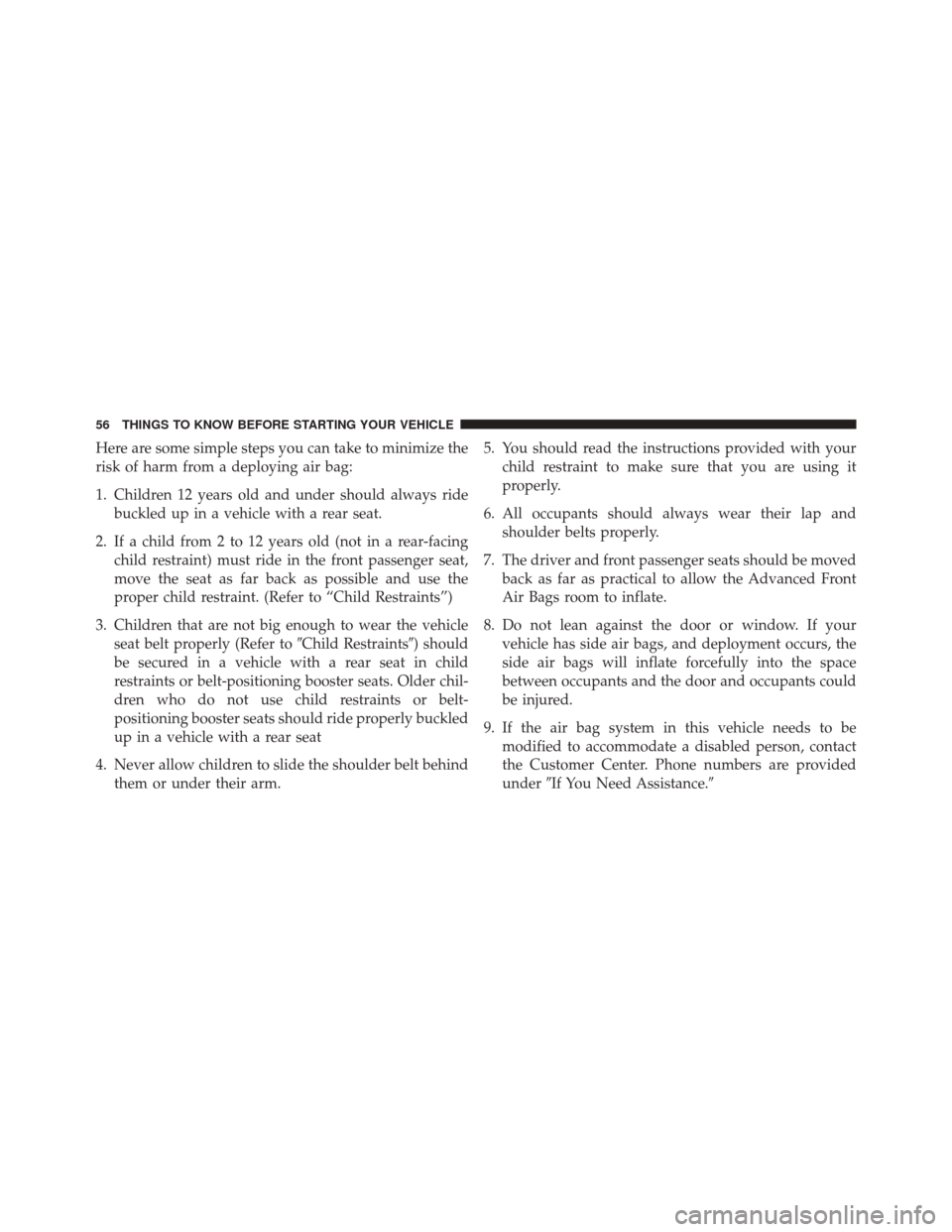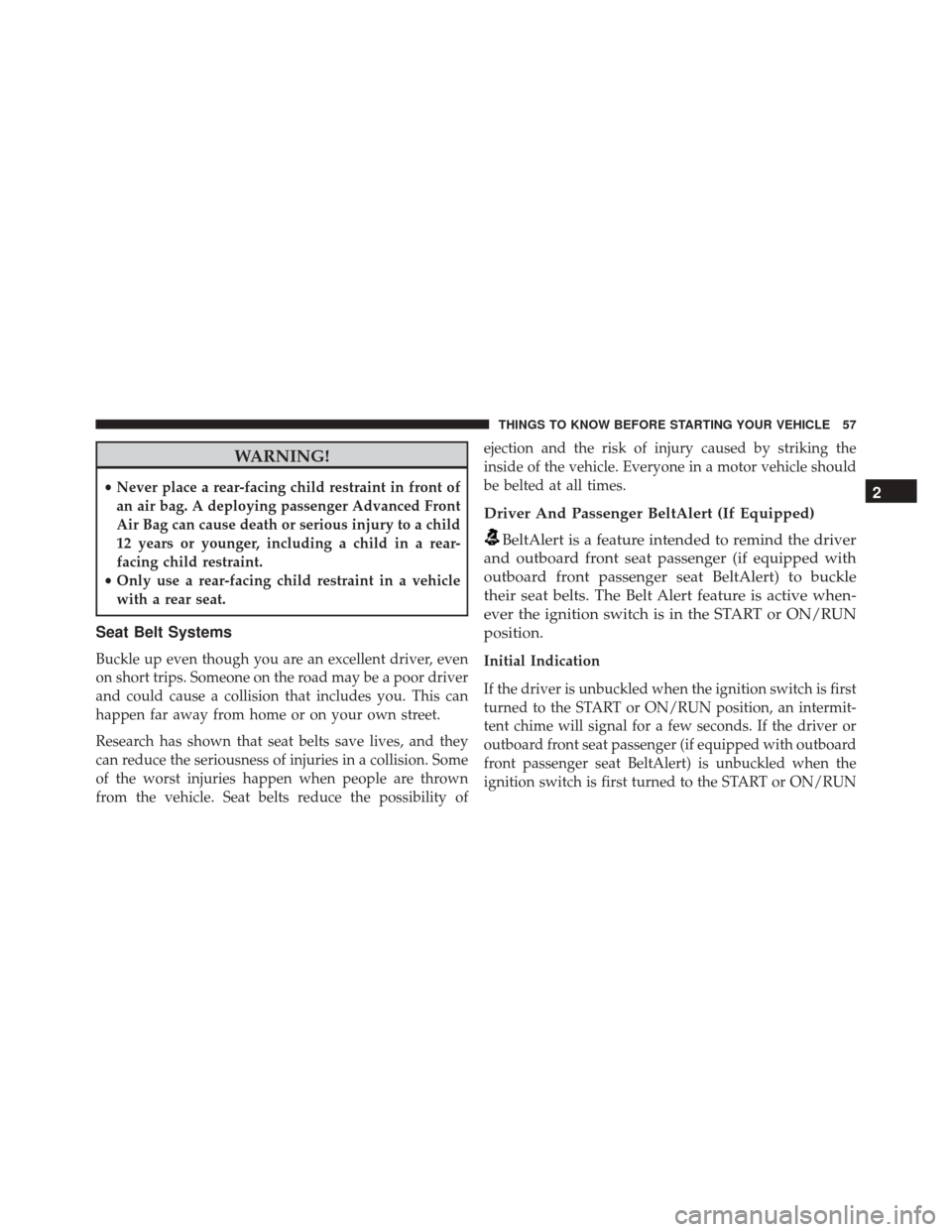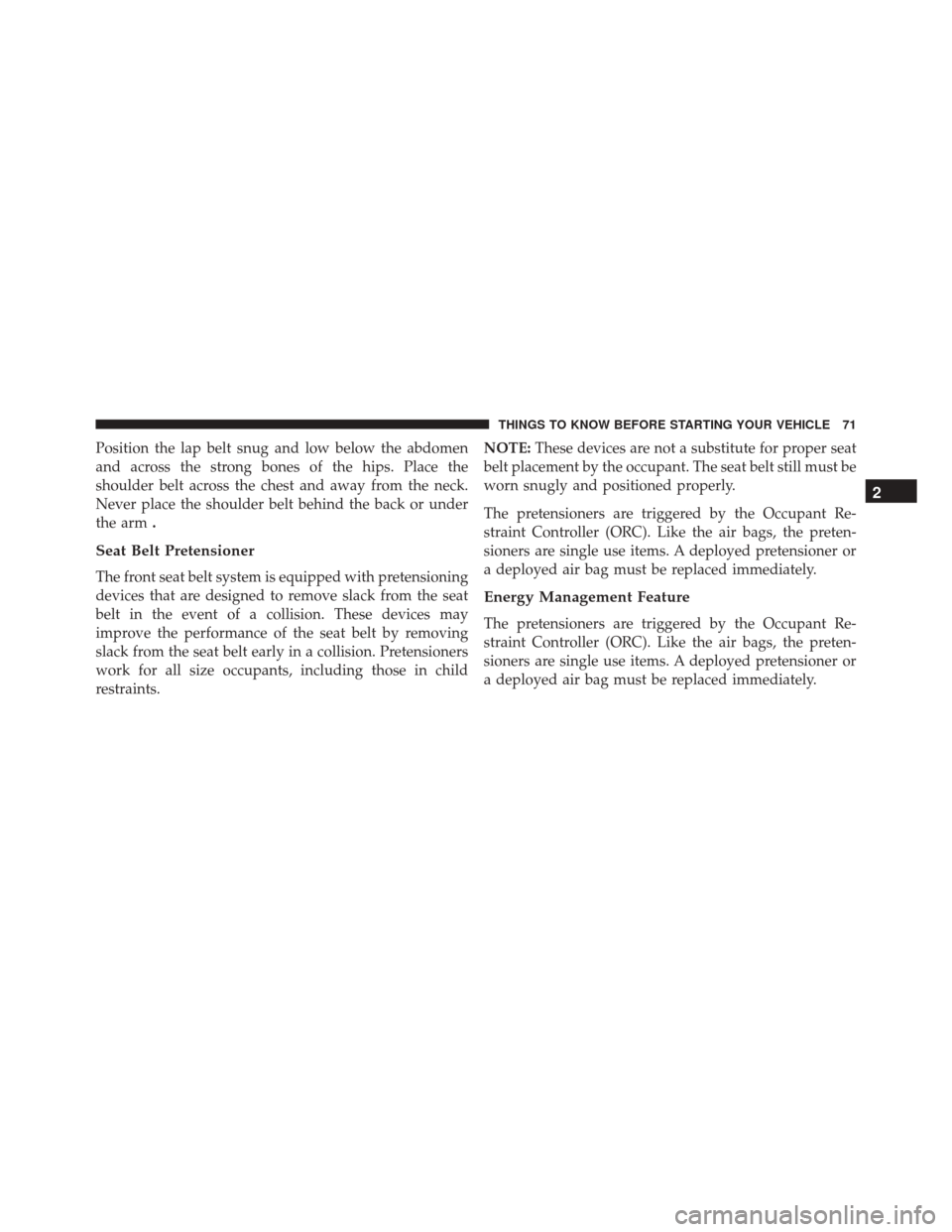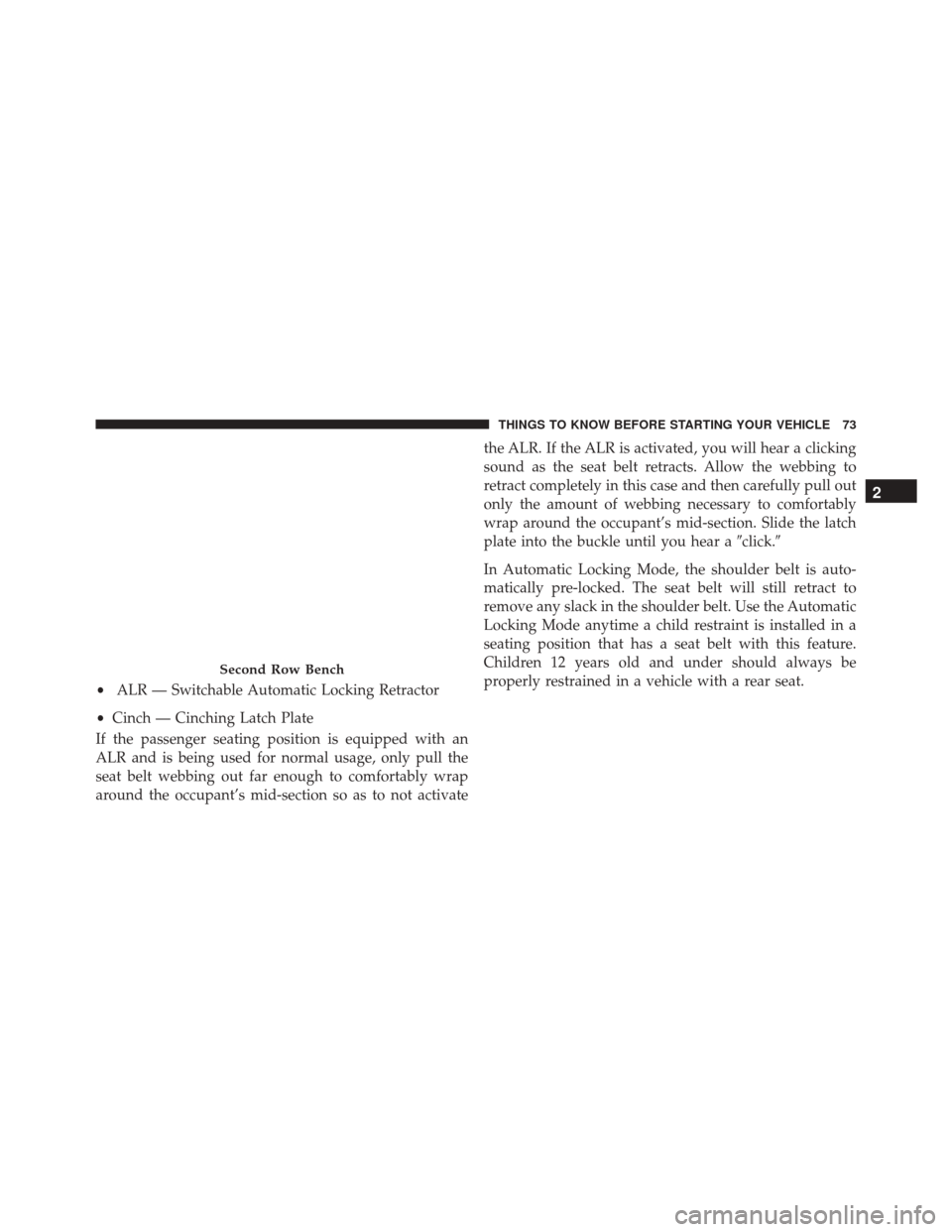Page 12 of 707

▫Programming Additional Transmitters ........27
▫ Transmitter Battery Replacement ...........28
▫ General Information ....................30
�
REMOTE STARTING SYSTEM — IF EQUIPPED . .30
▫ How To Use Remote Start ................31
▫ Remote Start Abort Message On Electronic Vehicle
Information Center (EVIC) — If Equipped .....32
▫ To Enter Remote Start Mode ...............32
▫ To Enter The Vehicle After Remote Start ......33
▫ To Exit Remote Start Mode And Drive The
Vehicle ..............................33
▫ Cancel Remote Start ....................33
▫ To Turn Off The Engine While In Remote Start
Mode ...............................34 ▫
When To Reset Remote Start ..............34
� DOOR LOCKS .........................34
▫ Manual Door Locks .....................34
▫ Power Door Locks — If Equipped ..........36
� WINDOWS ...........................38
▫ Power Vent Windows — If Equipped ........38
▫ Power Windows .......................38
� SLIDING SIDE DOOR ....................43
▫ Power Sliding Side Door — If Equipped ......44
▫ Sliding Side Door Child Protection Lock ......48
� LIFTGATE ............................51
▫ Power Liftgate — If Equipped .............52
� OCCUPANT RESTRAINT SYSTEMS ..........55
10 THINGS TO KNOW BEFORE STARTING YOUR VEHICLE
Page 13 of 707
▫Important Safety Precautions ..............55
▫ Seat Belt Systems ......................57
▫ Supplemental Restraint System (SRS) ........78
▫ Child Restraints .......................93
▫ Transporting Pets .....................117
� ENGINE BREAK-IN RECOMMENDATIONS . . .118
� SAFETY TIPS .........................119 ▫
Transporting Passengers .................119
▫ Exhaust Gas .........................119
▫ Safety Checks You Should Make Inside The
Vehicle ............................ .120
▫ Periodic Safety Checks You Should Make Outside
The Vehicle ........................ .122
2
THINGS TO KNOW BEFORE STARTING YOUR VEHICLE 11
Page 57 of 707

WARNING!
•Driving with the liftgate open can allow poisonous
exhaust gases into your vehicle. You and your
passengers could be injured by these fumes. Keep
the liftgate closed when you are operating the
vehicle.
• If you are required to drive with the liftgate open,
make sure that all windows are closed, and the
climate control blower switch is set at high speed.
Do not use the recirculation mode.
Gas props support the liftgate in the open position.
However, because the gas pressure drops with tempera-
ture, it may be necessary to assist the props when
opening the liftgate in cold weather.
OCCUPANT RESTRAINT SYSTEMS
Some of the most important safety features in your
vehicle are the restraint systems:
• Seat Belt Systems
• Supplemental Restraint Systems (SRS) Air Bags
• Supplemental Active Head Restraints
• Child Restraints
Important Safety Precautions
Please pay close attention to the information in this
section. It tells you how to use your restraint system
properly, to keep you and your passengers as safe as
possible.
2
THINGS TO KNOW BEFORE STARTING YOUR VEHICLE 55
Page 58 of 707

Here are some simple steps you can take to minimize the
risk of harm from a deploying air bag:
1. Children 12 years old and under should always ridebuckled up in a vehicle with a rear seat.
2. If a child from 2 to 12 years old (not in a rear-facing child restraint) must ride in the front passenger seat,
move the seat as far back as possible and use the
proper child restraint. (Refer to “Child Restraints”)
3. Children that are not big enough to wear the vehicle seat belt properly (Refer to �Child Restraints�) should
be secured in a vehicle with a rear seat in child
restraints or belt-positioning booster seats. Older chil-
dren who do not use child restraints or belt-
positioning booster seats should ride properly buckled
up in a vehicle with a rear seat
4. Never allow children to slide the shoulder belt behind them or under their arm. 5. You should read the instructions provided with your
child restraint to make sure that you are using it
properly.
6. All occupants should always wear their lap and shoulder belts properly.
7. The driver and front passenger seats should be moved back as far as practical to allow the Advanced Front
Air Bags room to inflate.
8. Do not lean against the door or window. If your vehicle has side air bags, and deployment occurs, the
side air bags will inflate forcefully into the space
between occupants and the door and occupants could
be injured.
9. If the air bag system in this vehicle needs to be modified to accommodate a disabled person, contact
the Customer Center. Phone numbers are provided
under �If You Need Assistance.�
56 THINGS TO KNOW BEFORE STARTING YOUR VEHICLE
Page 59 of 707

WARNING!
•Never place a rear-facing child restraint in front of
an air bag. A deploying passenger Advanced Front
Air Bag can cause death or serious injury to a child
12 years or younger, including a child in a rear-
facing child restraint.
• Only use a rear-facing child restraint in a vehicle
with a rear seat.
Seat Belt Systems
Buckle up even though you are an excellent driver, even
on short trips. Someone on the road may be a poor driver
and could cause a collision that includes you. This can
happen far away from home or on your own street.
Research has shown that seat belts save lives, and they
can reduce the seriousness of injuries in a collision. Some
of the worst injuries happen when people are thrown
from the vehicle. Seat belts reduce the possibility of ejection and the risk of injury caused by striking the
inside of the vehicle. Everyone in a motor vehicle should
be belted at all times.
Driver And Passenger BeltAlert (If Equipped)
BeltAlert is a feature intended to remind the driver
and outboard front seat passenger (if equipped with
outboard front passenger seat BeltAlert) to buckle
their seat belts. The Belt Alert feature is active when-
ever the ignition switch is in the START or ON/RUN
position.
Initial Indication
If the driver is unbuckled when the ignition switch is first
turned to the START or ON/RUN position, an intermit-
tent chime will signal for a few seconds. If the driver or
outboard front seat passenger (if equipped with outboard
front passenger seat BeltAlert) is unbuckled when the
ignition switch is first turned to the START or ON/RUN
2
THINGS TO KNOW BEFORE STARTING YOUR VEHICLE 57
Page 73 of 707

Position the lap belt snug and low below the abdomen
and across the strong bones of the hips. Place the
shoulder belt across the chest and away from the neck.
Never place the shoulder belt behind the back or under
the arm.
Seat Belt Pretensioner
The front seat belt system is equipped with pretensioning
devices that are designed to remove slack from the seat
belt in the event of a collision. These devices may
improve the performance of the seat belt by removing
slack from the seat belt early in a collision. Pretensioners
work for all size occupants, including those in child
restraints. NOTE:
These devices are not a substitute for proper seat
belt placement by the occupant. The seat belt still must be
worn snugly and positioned properly.
The pretensioners are triggered by the Occupant Re-
straint Controller (ORC). Like the air bags, the preten-
sioners are single use items. A deployed pretensioner or
a deployed air bag must be replaced immediately.
Energy Management Feature
The pretensioners are triggered by the Occupant Re-
straint Controller (ORC). Like the air bags, the preten-
sioners are single use items. A deployed pretensioner or
a deployed air bag must be replaced immediately.
2
THINGS TO KNOW BEFORE STARTING YOUR VEHICLE 71
Page 74 of 707
Switchable Automatic Locking Retractors (ALR) —
If Equipped
The seat belts in the passenger seating positions may be
equipped with a Switchable Automatic Locking Retractor
(ALR) which is used to secure a child restraint system.
For additional information, refer to “Installing Child
Restraints Using The Vehicle Seat Belt” under the “Child
Restraints” section of this manual. The table below
defines the type of feature for each seating position.
Second Row Captains Chair
72 THINGS TO KNOW BEFORE STARTING YOUR VEHICLE
Page 75 of 707

If the passenger seating position is equipped with an
ALR and is being used for normal usage, only pull the
seat belt webbing out far enough to comfortably wrap
around the occupant’s mid-section so as to not activatethe ALR. If the ALR is activated, you will hear a clicking
sound as the seat belt retracts. Allow the webbing to
retract completely in this case and then carefully pull out
only the amount of webbing necessary to comfortably
wrap around the occupant’s mid-section. Slide the latch
plate into the buckle until you hear a
�click.�
In Automatic Locking Mode, the shoulder belt is auto-
matically pre-locked. The seat belt will still retract to
remove any slack in the shoulder belt. Use the Automatic
Locking Mode anytime a child restraint is installed in a
seating position that has a seat belt with this feature.
Children 12 years old and under should always be
properly restrained in a vehicle with a rear seat.
Second Row Bench
• ALR — Switchable Automatic Locking Retractor
• Cinch — Cinching Latch Plate
2
THINGS TO KNOW BEFORE STARTING YOUR VEHICLE 73